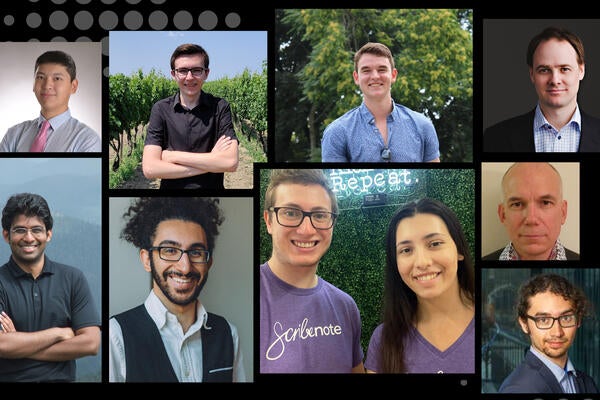
A robot to help reduce wildfire risk in remote areas
Enerza is creating a beetle-like robot that can predict power outages and wildfires

Enerza is creating a beetle-like robot that can predict power outages and wildfires
By Naomi Grosman VelocityNorth America has 10 million kilometres of overhead power lines, and when vegetation come into contact with one, it can be like tinder to a flame.
“Once they come in contact with trees, the risk of forest fires increases,” says Anson Maitland (PhD ’19), co-founder of Enerza, a company at Velocity, University of Waterloo’s startup incubator. “With our robot, utilities can spot vegetation risks, corrosion or birds' nests near the line and send out a team to handle it.”
He says that much of North America’s power infrastructure was built in the 1960’s or 70’s. Power lines are often found in rural, forested areas and only monitored on average once every five years. While aware of the problem and eager for a solution, utilities companies don’t know where to best spend their operating dollars.
And without better monitoring tools, it’s difficult to know where and when to do maintenance.
“How would they know which ones to maintain or replace?” says Maitland. “With the robot they can inspect infrastructure more frequently and know with confidence when and where to replace power lines or trim trees.”
Enerza co-founder James Aein says the company’s tech is not just a robot but also a grid analytics platform. Just like a health care provider uses medical imaging to investigate patients’ health before invasive procedures, it gives utilities a whole picture of risks and maintenance needs.

Utilities want to implement procedures to be more proactive when it comes to maintenance and risk management, but they need the data,” Aein says. “Using Enerza’s tech they can pinpoint hotspots, analyze the problem and manage it — they can be proactive instead of reactive.”
Aein and Maitland, who earned his PhD from the University of Waterloo’s Faculty of Engineering in 2019, started working out of Velocity in January, where they have set up a mock power line to validate their tech — a beetle-like, autonomous robotic platform. The robot collects data, which can be fed back to an analytics server, it also operates independently for extended periods of time and recharges itself on the line.
"Utilities are blind when it comes to these tens of thousands of kilometres of power lines — this would be its eyes and ears,” Maitland says.
Velocity accelerates entrepreneurs’ growth from ideas to early-stage startups and beyond. These founders have access to unmatched resources, collaboration space, funding and an expansive and experienced network made possible only by the University of Waterloo — Canada’s top university for founders. In the 15 years since its inception as a University of Waterloo residence, more than 400 Velocity companies have netted more than $26B USD in value.

Read more
Velocity welcomes six new companies to its downtown Kitchener innovation hub

Read more
Float secures $50 million to expand its financial products and innovate business-to-business financial services

Read more
Here are the people and events behind some of this year’s most compelling Waterloo stories
The University of Waterloo acknowledges that much of our work takes place on the traditional territory of the Neutral, Anishinaabeg, and Haudenosaunee peoples. Our main campus is situated on the Haldimand Tract, the land granted to the Six Nations that includes six miles on each side of the Grand River. Our active work toward reconciliation takes place across our campuses through research, learning, teaching, and community building, and is co-ordinated within the Office of Indigenous Relations.